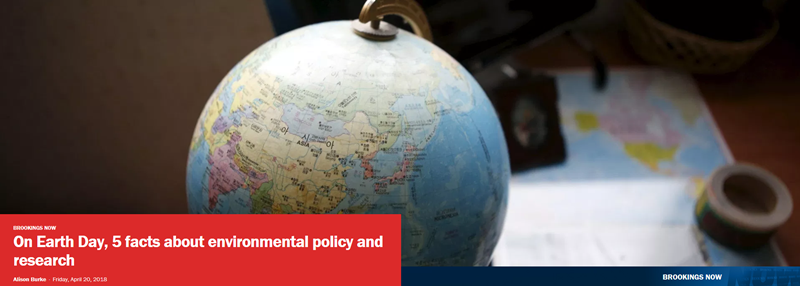
On Earth Day, 5 facts about environmental policy and research
Alison Burke
Friday, April 20, 2018
On April 22, 1970, 20 million Americans participated in massive rallies and events across the country with the goal of raising awareness of the deterioration of the environment, and to spur government action to support a healthier and more sustainable world. By the end of that year, their voices were heard: bipartisan efforts in Congress led to the creation of the United States Environmental Protection Agency, and the passage of the Clean Water, Clean Air, and the Endangered Species Acts. (For more on the history of Earth Day, listen to Nonresident Senior Fellow Nathan Hultman’s recent podcast on Earth Day during the Trump Administration.)
Forty-eight years later, Americans are still gathering around the country for Earth Day events, and this year the Earth Day Network has dedicated the day to providing the information and inspiration needed to fundamentally change human attitudes and behaviors about plastics. As you celebrate Earth Day, browse the facts below to learn more about what Brookings experts are saying about the state of our environment and the policies that affect it.
1. US household water use is on the decline, approaching levels not seen since the mid-1990s
According to Joseph Kane, associate fellow in the Metropolitan Policy Program, many households are using less water and putting less strain on the country’s scarce water resources following the drought in the Western United States in 2017. According to a new report from the U.S. Geological Survey , U.S. household water use is on the decline, approaching levels not seen since the mid-1990s. Steps toward greater water conservation in California and several other states appear to be taking hold, alongside a number of regulatory and technological advances in support of water efficiency, including plumbing fixture upgrades. And with greater efficiency come several benefits: from preserving long-term water supplies to reducing the need to build new infrastructure.
Still, warns Kane, even as households use less water, these drops are not distributed evenly across the country, and ongoing challenges remain concerning water efficiency and affordability in many regions.
2. Many nations are committed to addressing the effects of climate change on oceans
Under the Paris Agreement, nations made pledges known as nationally determined contributions (NDCs) that indicate how national governments intend to reduce their greenhouse emissions and contend with climate risks. In a recent paper in Nature Climate Change, a team from the Scripps Institution of Oceanography and David Victor, Co-Chair of the Cross-Brookings Initiative on Energy and Climate makes use of these pledges to explore how governments are grappling with some of the most pernicious and worrying impacts of climate change: those on the oceans.
The researchers found that in contrast to the past, when oceans received minimal attention in climate negotiations, 70 percent of 161 NDCs analyzed by the team include marine issues. And as Victor points out, those countries most vulnerable to sea level rise and those deemed “small island developing states” correlated powerfully with attention to the oceans.
3. The US is on track to become the world’s largest oil producer within a decade
In a recent congressional hearing, Fatih Birol, executive director of the International Energy Agency, described the United States as “the undisputed oil and gas leader in the world over the next several decades.” U.S. oil production is forecast to exceed 10 million barrels per day in 2018, surpassing Saudi Arabia and behind only Russia. In recent analysis, Foreign Policy Fellow Samantha Gross explores whether this incredible surge in production could make the U.S. “the new Saudi Arabia.” She argues it will not.
Gross contends that although the United States has become an indispensable source of oil and gas production, it is dissimilar to the operations of state-run producers like Saudi Aramco who will continue to play a unique role in global oil markets. But, she asks, “with a potential end to demand growth, will they change their strategy to compete more strongly in the market on price, acting more like the American producers?” Only time will tell, she concludes.
4. Natural disasters lead to reductions in educational attainment and academic performance—especially for adolescent girls
According to Erica Chuang, Jessie Pinchoff, and Stephanie Psaki, research has shown an overall reduction in educational attainment, lower academic performance, and higher rates of absenteeism among children who have experienced climate shocks. After these events, children may also miss school due to sickness (e.g., malnutrition during drought, or increased rates of diarrheal disease after floods), injury, or displacement. In the long run, this may reduce lifetime earnings when these children reach adulthood.
Moreover, climate events disproportionately affect vulnerable students, particularly adolescent girls. This pattern is particularly alarming say the researchers, as evidence suggests that climate-related shocks (cyclones, flash floods, wildfires) and stresses (drought, for example) are increasing in frequency and intensity. The relationship between girls’ education and climate events is complex, but the authors note that new research is exploring the problem—and suggesting potential solutions.
5. The rate of wildlife extinction is at its worst since the dinosaurs died out 65 million years ago
In a new her new book The Extinction Market: Wildlife Trafficking and How to Counter It, Vanda Felbab-Brown explains that the planet is experiencing alarming levels of species loss. This loss, she says, is caused in large part by intensified poaching and wildlife trafficking driven by expanding demand for medicines, food, and trophies. Affecting many more species than just the iconic elephants, rhinos, and tigers, Felbab-Brown explains that the rate of extinction is now as much as 1,000 times the historical average and at its worst since the dinosaurs died out 65 million years ago. In addition to causing irretrievable biodiversity loss, wildlife trafficking also poses serious threats to public health, potentially triggering a global pandemic.
Listen to Felbab-Brown discuss her book and the threats posed by poaching, hunting, and trafficking in the Brookings Cafeteria Podcast.


































